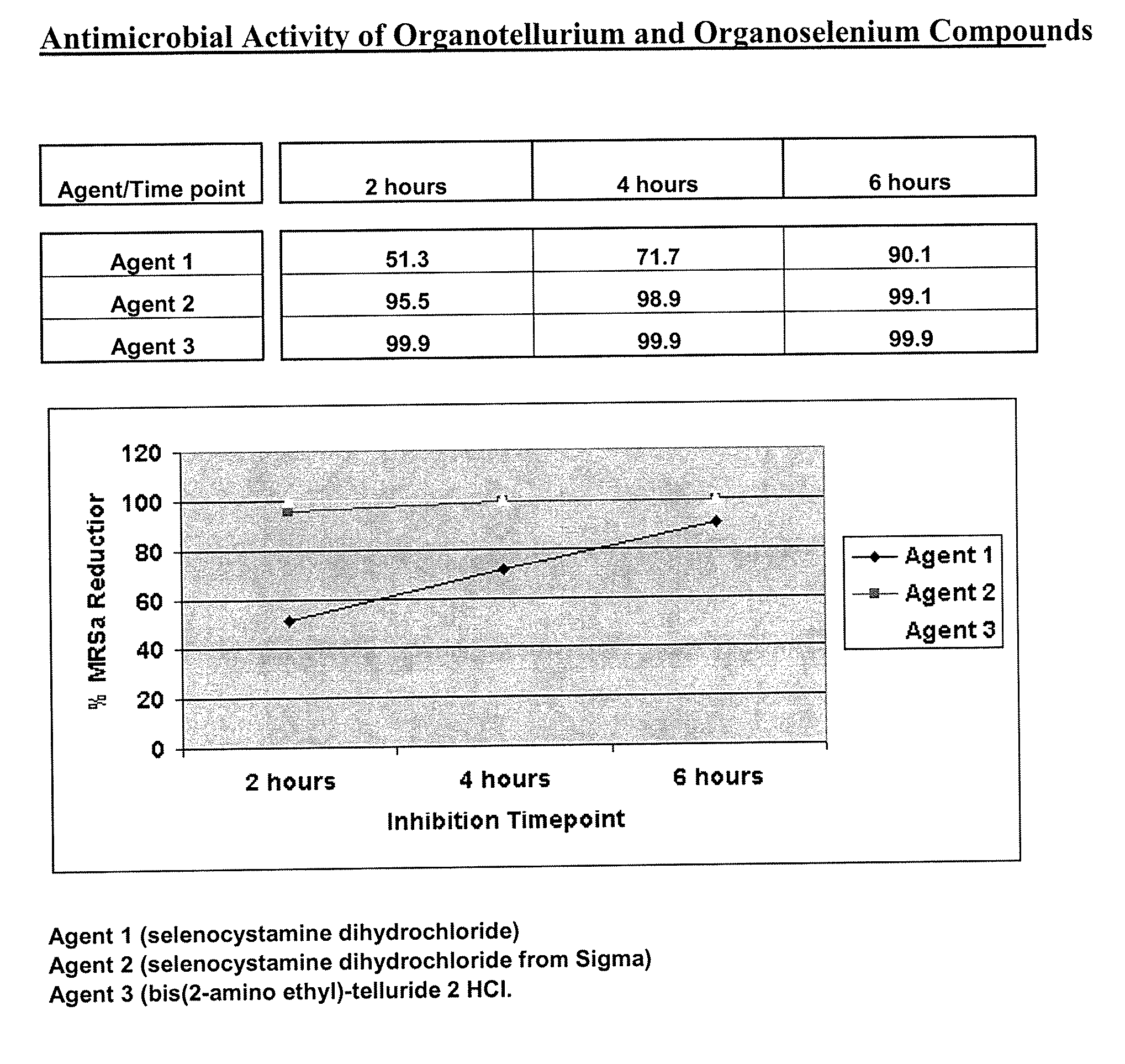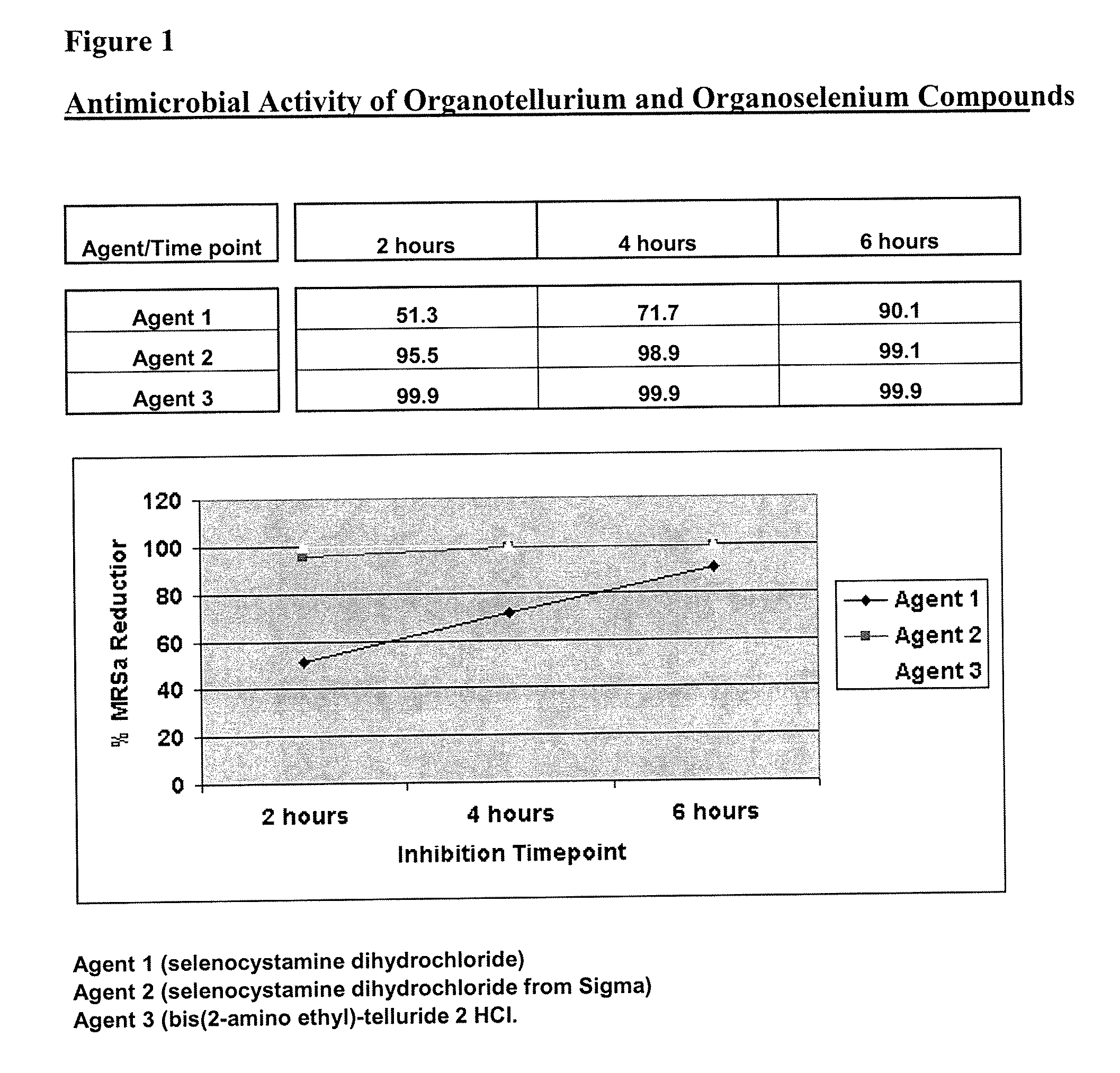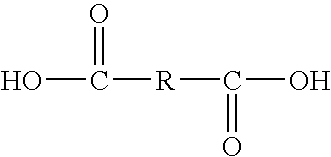Organotellurium and selenium-based antimicrobial formulations and articles
an organic selenium and antimicrobial technology, applied in the field of organic selenium-based antimicrobial formulations and articles, can solve the problems of antibiotic resistant bacteria, infection development and spread, and about 1-10% of catheters used eventually become contaminated, and achieve the effect of killing and/or inhibiting the growth and/or spreading, and potent antimicrobial activities
- Summary
- Abstract
- Description
- Claims
- Application Information
AI Technical Summary
Benefits of technology
Problems solved by technology
Method used
Image
Examples
example 1
Preparation of Selenocystamine dihydrochloride (2,2′-diselenodiethanamine dihydrochloride)
[0194]
[0195] To a 3-neck flask fitted with an N2 gas inlet, an addition funnel, and a gas outlet leading to a trap containing a 5% Pb(OAc)2 solution, was added selenium metal (4.5 gm, 56.9 mmol), followed by 25 mL H2O. In a separate flask, NaBH4 (4.5 gm, 118.5 mmol) was taken up in 25 mL H2O and the solution was transferred to the addition funnel. The selenium metal slurry at room temperature was stirred at a moderate rate and the NaBH4 solution was slowly added drop wise at such a rate to keep the gas evolution and effervescence at a moderate pace. The solution changed from grey to brown-red and finally to a clear light yellow after complete addition (approximately 50 min.). After 10 minutes a second amount of selenium metal (4.5 gm, 56.9 mmol) was added in portions. The solution turned a dark red-brown color and was stirred for another 20 minutes at room temperature. A solution of 2-chloro-e...
example 2
Preparation of 2,2′-tellurodiethanamine dihydrochloride
[0196]
[0197] To a 3-neck flask fitted with an N2 gas inlet, an addition funnel and a gas outlet leading to a trap containing a 5% Pb(OAc)2 solution, was added tellurium metal (10 gm, 78.4 mmol), followed by 250 mL H2O. The resulting slurry was de-oxygenated with N2 gas for 20 minutes. In a separate flask, NaBH4 (7.7 gm, 203.8 mmol) was taken up in 90 mL H2O, transferred to the addition funnel and the solution was de-oxygenated with N2 gas for 20 minutes. The tellurium metal slurry was heated to 65-70° C. and stirred at a moderate rate. The NaBH4 solution was slowly added drop wise at such a rate as to keep the gas evolution and effervescence at a moderate pace. The solution changed from graphite to metallic silver to dark purple to light pink and finally formed a clear, colorless solution after complete addition. After 20 minutes, the clear solution was cooled in an ice bath. A solution of 2-bromo-ethylamine hydrobromide (35.3 ...
example 3
Preparation of 2,2′-ditellurodiethanamine dihydrochloride
[0198]
[0199] To a 3-neck flask fitted with an N2 gas inlet, an addition funnel and a gas outlet leading to a trap containing a 5% Pb(OAc)2 solution, was added tellurium metal (4.0 gm, 31.4 mmol), followed by 100 mL H2O. The resulting slurry was de-oxygenated with N2 gas for 20 minutes. In a separate flask, NaBH4 (3.1 gm, 81.5 mmol) was taken up in 36 mL H2O, transferred to the addition funnel and the solution was de-oxygenated with N2 gas for 20 minutes. The tellurium metal slurry was heated to 65-70° C. and stirred at a moderate rate. The NaBH4 solution was slowly added drop wise at such a rate as to keep the gas evolution and effervescence at a moderate pace. The solution changed from graphite to metallic silver to dark purple to light pink and finally formed a clear, colorless solution after complete addition. Upon formation of the clear solution, a second amount of tellurium metal (4.0 gm, 31.4 mmol) was added in portions...
PUM
| Property | Measurement | Unit |
|---|---|---|
| Fraction | aaaaa | aaaaa |
| Fraction | aaaaa | aaaaa |
| Linear density | aaaaa | aaaaa |
Abstract
Description
Claims
Application Information
 Login to View More
Login to View More - R&D
- Intellectual Property
- Life Sciences
- Materials
- Tech Scout
- Unparalleled Data Quality
- Higher Quality Content
- 60% Fewer Hallucinations
Browse by: Latest US Patents, China's latest patents, Technical Efficacy Thesaurus, Application Domain, Technology Topic, Popular Technical Reports.
© 2025 PatSnap. All rights reserved.Legal|Privacy policy|Modern Slavery Act Transparency Statement|Sitemap|About US| Contact US: help@patsnap.com



